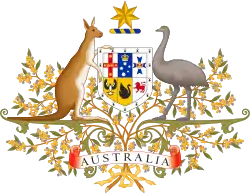Minister for Energy and Emissions Reduction
The Honorable Angus Taylor MP has served as the Minister for Energy and Emissions Reduction since August 2018.[1]It is a federal ministerial portfolio responsible for the coordination and implementation of sustainable energy policies by the Australian Government. These policy areas include the mitigation of greenhouse gas emissions, the promotion of energy efficiency, as well as adaptations to climate change within domestic and international contexts.
| Minister for Energy and Emissions Reduction | |
|---|---|
| Department of the Environment and Energy | |
| Style | The Honourable |
| Appointer | Governor-General on the recommendation of the Prime Minister of Australia |
| Inaugural holder | Penny Wong |
| Formation | 3 December 2007 |
| Website | www |
History
The precursor to the department was led by Secretary Blair Comley who reported to the Minister for Climate Change and Energy Efficiency, Greg Combet. The Minister was assisted by the Secretary for Climate Change and Energy Efficiency, Mark Dreyfus. The Clean Energy Regulator was an associated statutory authority formed on 2 April 2012.
On 25 March 2013, the responsibility for Climate Change policy passed to the newly formed Department of Industry, Innovation, Climate Change, Science, Research and Tertiary Education, and the duties of the Ministry of Energy passed to the Department of Resources, Energy and Tourism. Following the 2013 Australian federal election the responsibility for energy was shifted to the Minister for Industry, Innovation and Science under the Abbott Government.
After the 2016 Australian federal election, the responsibilities were passed to the Minister of the Environment and Energy under the Turnbull Government.[2] Following the appointment of Scott Morrison as Prime Minister in August of 2018, Josh Frydenberg was elevated to Treasurer of Australia, whereby Frydenberg's previous ministerial positions were separated, with Melissa Price as Minister of the Environment and Angus Taylor as Minister for Energy.
On 1 February 2020, An Administrative Arrangements Order (AAOs) was executed by the Australian Government. This order required small business and energy functions be passed to the renamed Department of Industry, Science, Energy and Resources.[3]
Objectives
The department deals with:[4]
- Development and coordination of domestic and international climate change policy
- International climate change negotiations
- Design and implementation of emissions trading
- Mandatory renewable energy target policy, regulation, and co-ordination
- Greenhouse emissions and energy consumption reporting
- Climate change adaptation strategy and co-ordination
- Co-ordination of climate change science activities
See also
- Carbon tax in Australia
- List of Australian Commonwealth Government entities
References
- Department of Industry, Science (4 September 2020). "Taylor". www.minister.industry.gov.au. Retrieved 4 September 2020.
- "Ministers".
- "Administrative Arrangements Order made on 5 December 2019 with effect from 1 February 2020". Prime Minister and Cabinet. 1 February 2020. Ministers
- "Administrative Arrangements Order" (PDF). Government of Australia. 25 January 2008. Archived from the original (PDF) on 22 July 2008. Retrieved 2008-08-27.

